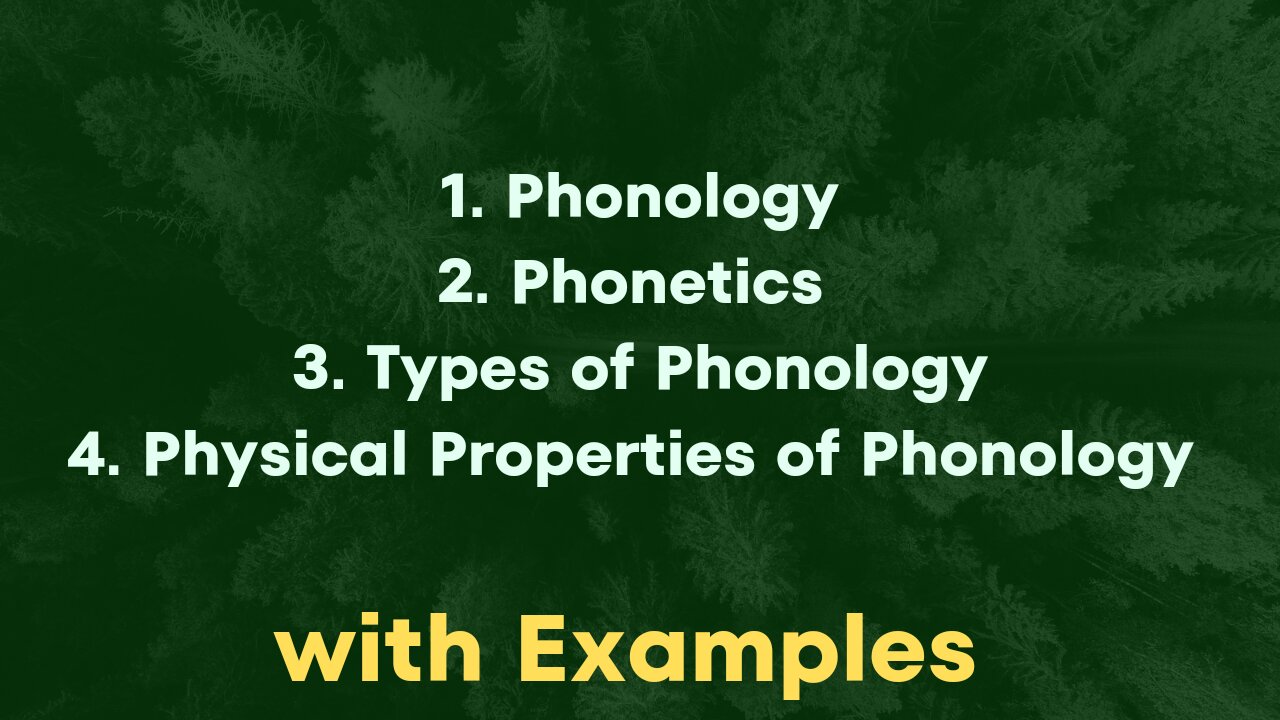Premium Only Content

Phonology| Branches of Phonology| Physical Properties of Phonology| Phonology and its Types.
#phonology
#typesofphonology
#physicalpropertuesofphonology
#phoneticsandphonology
#linguistics
This video is about:
Phonology| Types of Phonology| Physical Properties of Phonology| Phonology and its Types in English.
Phonology is the study of the sound patterns and rules that govern how sounds are organized and used in a particular language. It involves analyzing the distinct phonemes (speech sounds) of a language, their distribution, and the rules that dictate their interactions.
For example, in English, the words "pat" and "bat" differ in meaning due to the phoneme /p/ in "pat" being replaced by /b/ in "bat." The rule that governs this change is called voicing assimilation, where the initial consonant sound takes on the voicing of the following consonant sound. Phonology helps us understand how these rules shape the pronunciation of words in a language.
There are a few different types of phonology that focus on different aspects of sound patterns in language. Here are three main types with examples:
Segmental Phonology: This type examines individual speech sounds or segments, such as consonants and vowels. It deals with the inventory of sounds in a language and how they are combined to form words. An example is the distinction between the English consonant sounds /p/ and /b/, as in the words "pat" and "bat."
Suprasegmental Phonology: This type looks at features that extend beyond individual segments, like intonation, stress patterns, and rhythm. For instance, in English, rising intonation at the end of a statement can turn it into a question, as in "You're coming?" versus "You're coming."
Autosegmental Phonology: This type focuses on the relationships and interactions between segments. It explores phenomena like tone and vowel harmony. An example is tone in Mandarin Chinese, where different tones on a single syllable can change the meaning. For example, the syllable "ma" with different tones can mean "mother," "hemp," "horse," or "scold," despite having the same segmental makeup.
These types of phonology help linguists understand how sound patterns are organized in languages and how these patterns contribute to linguistic meaning and communication.
Phonetics and phonology are both subfields of linguistics that deal with the study of speech sounds, but they focus on different aspects and have distinct goals:
Phonetics: Phonetics is the study of the physical properties of speech sounds, including their articulation (how speech sounds are produced), acoustic properties (how they are transmitted as sound waves), and auditory perception (how they are heard and interpreted). Phonetics is concerned with the physical characteristics of sounds, such as their place and manner of articulation. For example, it examines how the lips, tongue, and vocal cords move to produce different sounds.
Phonology: Phonology, on the other hand, is the study of the abstract, cognitive aspects of speech sounds in language. It deals with the way speech sounds function and pattern within a particular language, including the rules and patterns governing their distribution and interaction. Phonology is interested in how speech sounds are organized into distinct phonemes and how these phonemes affect meaning. For example, phonology explains why changing the /p/ sound to a /b/ sound in English can change the meaning of a word (e.g., "pat" vs. "bat").
In summary, phonetics focuses on the physical properties of speech sounds, while phonology focuses on the abstract patterns and rules governing the use of speech sounds in a language.
The physical properties studied in phonetics include the articulation, acoustic characteristics, and auditory perception of speech sounds. Here are some examples of these properties:
Articulation: Phonetics examines how speech sounds are produced using the articulatory organs, such as the lips, tongue, teeth, and vocal cords. Examples include:
Place of Articulation: The location where airflow is obstructed to produce a sound, like the /t/ sound in "top" being produced with the tongue against the alveolar ridge.
Manner of Articulation: The degree of constriction or closure of airflow, like the difference between a stop sound (/p/) and a fricative sound (/f/).
Acoustic Characteristics: Phonetics studies the acoustic properties of speech sounds, which involve the transmission of sound waves through the air. Examples include...
-
 1:17:36
1:17:36
The White House
3 hours agoPress Secretary Karoline Leavitt Briefs Members of the New Media, Apr. 30, 2025
49.2K24 -
 LIVE
LIVE
RiftTV/Slightly Offensive
2 hours ago $3.07 earnedWitnessing The COMPLETE COLLAPSE of American Society | Guests: Gavin McInnes and Anthony Cumia
857 watching -
 LIVE
LIVE
The HotSeat
1 hour agoBuffalo Schools PROTECTED PREDATORS – Angry Cops Exposes Child Abuse Cover-Up from Hell!
620 watching -
 LIVE
LIVE
Film Threat
5 hours agoTHUNDERBOLTS* REVIEW! | Hollywood on the Rocks
130 watching -
 8:09
8:09
Talk Nerdy Sports - The Ultimate Sports Betting Podcast
1 hour ago4/30/25 - AI Predicts a Bloodbath: April 30 Picks Are Too Sharp to Fade
3.97K -
![[Ep 661] Oh Canada: What Have You Done? | CA: Not a Felony To Purchase 16 & 17 Year Olds For Sex](https://1a-1791.com/video/fww1/ac/s8/1/N/X/z/G/NXzGy.0kob-small-Ep-661-Oh-Canada-What-Have-.jpg) LIVE
LIVE
The Nunn Report - w/ Dan Nunn
1 hour ago[Ep 661] Oh Canada: What Have You Done? | CA: Not a Felony To Purchase 16 & 17 Year Olds For Sex
129 watching -
 1:00:27
1:00:27
Crypto Power Hour
7 hours ago $0.80 earnedUnleashing the Future: The Thrilling Realm of Blockchain Revolution
12.7K4 -
 1:09:05
1:09:05
Jeff Ahern
2 hours ago $0.87 earnedNever Woke Wednesday with Jeff Ahern
11.8K2 -
 1:14:16
1:14:16
Sean Unpaved
3 hours agoGridiron Fines, Playoff Grinds & Diamond Blasts
44.9K -
 1:08:29
1:08:29
Russell Brand
4 hours agoWas This a Rehearsal for the Next Global Event? – SF575
119K69